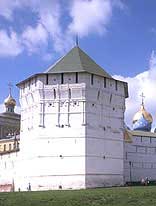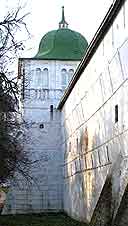 In the 16th century twelve three-tiered towers were constructed along the severe walls. The Monastery became a powerful fortress. The towers were defensive. Four of them were in the corners, the rest – in the curtain walls. One of the strongest towers was called after the neighboring Good Friday Monastery. The Tower replaced the old structure that was blown up during the siege of the Monastery (1608 – 1610). Like other corner towers, it is octagonal and has six tiers with loop-holes. Originally it was crowned with a high tent and a watching platform. It looks massive, austere and inaccessible.
In the 16th century twelve three-tiered towers were constructed along the severe walls. The Monastery became a powerful fortress. The towers were defensive. Four of them were in the corners, the rest – in the curtain walls. One of the strongest towers was called after the neighboring Good Friday Monastery. The Tower replaced the old structure that was blown up during the siege of the Monastery (1608 – 1610). Like other corner towers, it is octagonal and has six tiers with loop-holes. Originally it was crowned with a high tent and a watching platform. It looks massive, austere and inaccessible.
The Onion Tower (16-17 cc.)
 The Onion Tower is situated between the Good Friday and Water Towers. It was constructed for the Monastery defense together with the fortress wall in the mid-16th century. There were 50 loop-holes in four tiers. Its height was 19 meters. The Tower was called after the neighboring onion garden. In the 19th
century, the upper tier of the southern wall, between the Water and Onion Towers, was arranged as a pavilion opening a good view of the surroundings.
The Onion Tower is situated between the Good Friday and Water Towers. It was constructed for the Monastery defense together with the fortress wall in the mid-16th century. There were 50 loop-holes in four tiers. Its height was 19 meters. The Tower was called after the neighboring onion garden. In the 19th
century, the upper tier of the southern wall, between the Water and Onion Towers, was arranged as a pavilion opening a good view of the surroundings.
|


